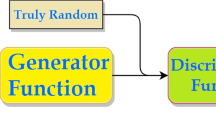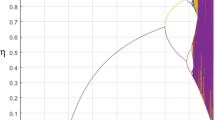Abstract
Neural cryptography is a new way to create shared secret key. It is based on synchronization of Tree Parity Machines (TPM) by mutual learning. Two neural networks trained on their mutual output bits synchronize to a state with identical time dependent weights. This has been used for creation of a secure cryptographic secret key using a public channel. In this paper a genetic approach has been used in the field of neural cryptography for synchronizing tree parity machines by mutual learning process. Here a best fit weight vector is found using a genetic algorithm and then the training process is done for the feed forward network. The proposed approach improves the process of synchronization.
Access this chapter
Tax calculation will be finalised at checkout
Purchases are for personal use only
Preview
Unable to display preview. Download preview PDF.
Similar content being viewed by others
References
Kinzel, W., Kanter, I.: Neural Cryptography. cond mat/0208453 (2002)
Rosen-Zvi, M., Kanter, I., Kinzel, W.: Cryptography based on Neural Networks: Analytical Results, cond- mat/0202350 (2002)
Kanter, I., Kinzel, W., Kanter, E.: Secure Exchange of Information by Synchronization of Neural Networks. Europhys. Letter 57, 141–147 (2002)
Goldberg, D.E.: Genetic Algorithms in Search, Optimization and Machine Learning. Addison-Wesley
Konar, A.: Computational Intelligence. Principles, Techniques and Applications. Springer, Heidelberg (2005)
Rukhin, A., Soto, J., Nechvatal, J., Smid, M., Barker, E., Leigh, S., Levenson, M., Vangel, M., Banks, D., Heckert, A., Dray, J., Vo, S.: A Statistical test suite for random and pseudorandom number generators for Cryptographic Applications
Klein, E., Mislovathy, R., Kanter, I., Ruttor, A., Kinzel, W.: Synchronization of Neural Networks by Mutual Learning and its Application to Cryptography. In: Advances in Neural Information Processing Systems, vol. 17, pp. 689–696. MIT Press, Cambridge (2005)
Klimov, A., Mityagin, A., Shamir, A.: Analysis of Neural Cryptography. In: Zheng, Y. (ed.) ASIACRYPT 2002. LNCS, vol. 2501, pp. 288–298. Springer, Heidelberg (2002)
Author information
Authors and Affiliations
Editor information
Editors and Affiliations
Rights and permissions
Copyright information
© 2012 Springer-Verlag Berlin Heidelberg
About this paper
Cite this paper
Santhanalakshmi, S., Sudarshan, T.S.B., Patra, G.K. (2012). Neural Synchronization by Mutual Learning Using Genetic Approach for Secure Key Generation. In: Thampi, S.M., Zomaya, A.Y., Strufe, T., Alcaraz Calero, J.M., Thomas, T. (eds) Recent Trends in Computer Networks and Distributed Systems Security. SNDS 2012. Communications in Computer and Information Science, vol 335. Springer, Berlin, Heidelberg. https://doi.org/10.1007/978-3-642-34135-9_41
Download citation
DOI: https://doi.org/10.1007/978-3-642-34135-9_41
Publisher Name: Springer, Berlin, Heidelberg
Print ISBN: 978-3-642-34134-2
Online ISBN: 978-3-642-34135-9
eBook Packages: Computer ScienceComputer Science (R0)




